Submitted:
30 September 2023
Posted:
11 October 2023
You are already at the latest version
Abstract
Keywords:
1. Introduction
2. Study Area
3. Methodology
4. Mapping of Coseismic Landside Hazard
4.1. Static Factor of Safety Map
4.2. Critical Acceleration Map
4.3. Predicted Dispalcement Map
4.4. Coseismic Landslides Hazard Map
5. Discussion
6. Conclusions
Author Contributions
Funding
Data Availability Statement
Acknowledgments
Conflicts of Interest
References
- Keefer, D.K. Landslides Caused by Earthquakes. Geol Soc Am Bull GSA Bull. 1984, 95, 406–421. [Google Scholar] [CrossRef]
- Terzaghi, K. Mechanism of Landslides. In Application of Geology to Engineering Practice; Paige, S., Ed.; Geological Society of America: New York, N. Y, 1950; pp. 83–123. ISBN 0-8137-4301-X. [Google Scholar] [CrossRef]
- Clough, R.W.; Chopra, A.K. Earthquake Stress Analysis in Earth Dams. J. Eng. Mech. Div. 1966, 92, 197–212. [Google Scholar] [CrossRef]
- Newmark, N.M. Effects of Earthquakes on Dams and Embankments. Géotechnique 1965, 15, 139–160. [Google Scholar] [CrossRef]
- Jibson, R.W. Methods for Assessing the Stability of Slopes during Earthquakes—A Retrospective. Eng. Geol. 2011, 122, 43–50. [Google Scholar] [CrossRef]
- Franklin, A.G.; Chang, F.K. Earthquake Resistance of Earth and Rock-Fill Dams: Report 5, Permanent Displacements of Earth Embankments by Newmark Sliding Block Analysis; Department of Defense, Department of the Army, Corps of Engineers, Waterways Experiment Station, Soils and Pavements Laboratory, 1977. [Google Scholar]
- Makdisi, F.I.; Seed, H.B. Simplified Procedure for Estimating Dam and Embankment Earthquake-Induced Deformations. J. Geotech. Eng. Div. 1978, 104, 849–867. [Google Scholar] [CrossRef]
- Bray, J.D.; Rathje, E.M. Earthquake-Induced Displacements of Solid-Waste Landfills. J. Geotech. Geoenvironmental Eng. 1998, 124, 242–253. [Google Scholar] [CrossRef]
- Bray, J.D.; Travasarou, T. Simplified Procedure for Estimating Earthquake-Induced Deviatoric Slope Displacements. J. Geotech. Geoenvironmental Eng. 2007, 133, 381–392. [Google Scholar] [CrossRef]
- Rathje, E.M.; Bray, J.D. An Examination of Simplified Earthquake-Induced Displacement Procedures for Earth Structures. Can. Geotech. J. 1999, 36, 72–87. [Google Scholar] [CrossRef]
- Rathje, E.M.; Bray, J.D. Nonlinear Coupled Seismic Sliding Analysis of Earth Structures. J. Geotech. Geoenvironmental Eng. 2000, 126, 1002–1014. [Google Scholar] [CrossRef]
- Jibson, R.W.; Harp, E.L.; Michael, J.A. A Method for Producing Digital Probabilistic Seismic Landslide Hazard Maps; an Example from the Los Angeles, California, Area. Open-File Rep. 1998. [Google Scholar] [CrossRef]
- Jibson, R.W.; Harp, E.L.; Michael, J.A. A Method for Producing Digital Probabilistic Seismic Landslide Hazard Maps. Eng. Geol. 2000, 58, 271–289. [Google Scholar] [CrossRef]
- Yuan, R.; Deng, Q.; Cunningham, D.; Han, Z.; Zhang, D.; Zhang, B. Newmark Displacement Model for Landslides Induced by the 2013 Ms 7.0 Lushan Earthquake, China. Front. Earth Sci. 2016, 10, 740–750. [Google Scholar] [CrossRef]
- Zhang, Y.; Xiang, C.; Chen, Y.; Cheng, Q.; Xiao, L.; Yu, P.; Chang, Z. Permanent Displacement Models of Earthquake-Induced Landslides Considering near-Fault Pulse-like Ground Motions. J. Mt. Sci. 2019, 16, 1244–1257. [Google Scholar] [CrossRef]
- Jibson, R.W. Regression Models for Estimating Coseismic Landslide Displacement. Eng. Geol. 2007, 91, 209–218. [Google Scholar] [CrossRef]
- Zhang, Y.; Xiang, C.; Yu, P.; Zhao, L.; Zhao, J.X.; Fu, H. Investigation of Permanent Displacements of Near-Fault Seismic Slopes by a General Sliding Block Model. Landslides 2022, 19, 187–197. [Google Scholar] [CrossRef]
- Gu, D. Engineering Geomechanics of Rock Mass; Science Press: Beijing, 1979. [Google Scholar]
- Hoek, E.; Bray, J.D. Rock Slope Engineering; 3rd editon.; Taylor & Francis: Abingdon, 1981. [Google Scholar]
- Harp, E.L.; Jibson, R.W. Landslides Triggered by the 1994 Northridge, California, Earthquake. Bull. Seismol. Soc. Am. 1996, 86, S319–S332. [Google Scholar] [CrossRef]
- Khazai, B.; Sitar, N. Evaluation of Factors Controlling Earthquake-Induced Landslides Caused by Chi-Chi Earthquake and Comparison with the Northridge and Loma Prieta Events. Eng. Geol. 2004, 71, 79–95. [Google Scholar] [CrossRef]
- Dai, F.C.; Xu, C.; Yao, X.; Xu, L.; Tu, X.B.; Gong, Q.M. Spatial Distribution of Landslides Triggered by the 2008 Ms 8.0 Wenchuan Earthquake, China. J. Asian Earth Sci. 2011, 40, 883–895. [Google Scholar] [CrossRef]
- Tang, C.; Ma, G.; Chang, M.; Li, W.; Zhang, D.; Jia, T.; Zhou, Z. Landslides Triggered by the 20 April 2013 Lushan Earthquake, Sichuan Province, China. Eng. Geol. 2015, 187, 45–55. [Google Scholar] [CrossRef]
- Qi, S.; Yan, C.; Liu, C. Two Typical Types of Earthquake Triggered Landslides and Their Mechanisms.; Banff, Canada, June 3 2012; pp. 1819–1823.
- Zang, M.; Qi, S.; Zou, Y.; Sheng, Z.; Zamora, B.S. An Improved Method of Newmark Analysis for Mapping Hazards of Coseismic Landslides. Nat. Hazards Earth Syst. Sci. 2020, 20, 713–726. [Google Scholar] [CrossRef]
- Barton, N. Review of a New Shear-Strength Criterion for Rock Joints. Eng. Geol. 1973, 7, 287–332. [Google Scholar] [CrossRef]
- Xu, X.-W.; Jiang, G.-Y.; Yu, G.-H.; Wu, X.-Y.; Zhang, J.-G.; Li, X. Discussion on Seismogenic Fault of the Ludian Ms6.5 Earthquake and Its Tectonic Attribution. Chin. J. Geophys. 2014, 57, 3060–3068. [Google Scholar]
- Xu, X.; Wen, X.; Han, Z.; Chen, G.; Li, C.; Zheng, W.; Zhnag, S.; Ren, Z.; Xu, C.; Tan, X.; et al. Lushan MS7.0 Earthquake: A Blind Reserve-Fault Event. Chin. Sci. Bull. 2013, 58, 3437–3443. [Google Scholar] [CrossRef]
- Han, Z.; Ren, Z.; Wang, H.; Wang, M. The Surface Rupture Signs of the Lushan “4.20” Ms 7.0 Earthquake at Longmen Township, Lushan County and Its Discussion. Seismol. Geol. 2013, 35, 388–397. [Google Scholar]
- Chen, X.L.; Yu, L.; Wang, M.M.; Lin, C.X.; Liu, C.G.; Li, J.Y. Brief Communication: Landslides Triggered by the Ms = 7.0 Lushan Earthquake, China. Nat. Hazards Earth Syst. Sci. 2014, 14, 1257–1267. [Google Scholar] [CrossRef]
- Xu, C.; Xu, X.; Zheng, W.; Wei, Z.; Tan, X.; Han, Z.; Li, C.; Liang, M.; Li, Z.; Wang, H.; et al. Landslides Triggered by the April 20, 2013 Lushan, Sichuan Province Ms 7.0 Strong Earthquake of China. Seismol. Geol. 2013, 35, 641–660. [Google Scholar]
- Xu, C.; Xu, X.; Shyu, J.B.H. Database and Spatial Distribution of Landslides Triggered by the Lushan, China Mw 6.6 Earthquake of 20 April 2013. Geomorphology 2015, 248, 77–92. [Google Scholar] [CrossRef]
- Newmark, N.M. Effects of Earthquakes on Dams and Embankments. Géotechnique 1965, 15, 139–160. [Google Scholar] [CrossRef]
- Zang, M.; Qi, S.; Zou, Y.; Sheng, Z.; Zamora, B.S. An Improved Method of Newmark Analysis for Mapping Hazards of Coseismic Landslides. Nat. Hazards Earth Syst. Sci. 2020, 20, 713–726. [Google Scholar] [CrossRef]
- Khazai, B.; Sitar, N. Evaluation of Factors Controlling Earthquake-Induced Landslides Caused by Chi-Chi Earthquake and Comparison with the Northridge and Loma Prieta Events. Eng. Geol. 2004, 71, 79–95. [Google Scholar] [CrossRef]
- Barton, N.; Bandis, S. Effects of Block Size on the Shear Behavior of Jointed Rock; Berkeley: California, USA, 1982; pp. 739–760. [Google Scholar]
- Ambraseys, N.N.; Menu, J.M. Earthquake-Induced Ground Displacements. Earthq. Eng. Struct. Dyn. 1988, 16, 985–1006. [Google Scholar] [CrossRef]
- Bray, J.D.; Travasarou, T. Simplified Procedure for Estimating Earthquake-Induced Deviatoric Slope Displacements. J. Geotech. Geoenvironmental Eng. 2007, 133, 381–392. [Google Scholar] [CrossRef]
- Saygili, G.; Rathje, E.M. Empirical Predictive Models for Earthquake-Induced Sliding Displacements of Slopes. J. Geotech. Geoenvironmental Eng. 2008, 134, 790–803. [Google Scholar] [CrossRef]
- Rathje, E.M.; Saygili, G. Probabilistic Assessment of Earthquake-Induced Sliding Displacements of Natural Slopes. Bull. N. Z. Soc. Earthq. Eng. 2009, 42, 18–27. [Google Scholar] [CrossRef]
- Hsieh, S.-Y.; Lee, C.-T. Empirical Estimation of the Newmark Displacement from the Arias Intensity and Critical Acceleration. Eng. Geol. 2011, 122, 34–42. [Google Scholar] [CrossRef]
- Shortliffe, E.H.; Buchanan, B.G. A Model of Inexact Reasoning in Medicine. Math. Biosci. 1975, 23, 351–379. [Google Scholar] [CrossRef]
- Heckerman, D. Probabilistic Interpretations for Mycin’s Certainty Factors* *This Work Was Supported in Part by the Josiah Macy, Jr. Foundation, the Henry J. Kaiser Family Foundation, and the Ford Aerospace Corporation. Computing Facilities Were Provided by the SUMEX-AIM Resource under NIH Grant RR-00785. In Machine Intelligence and Pattern Recognition : Uncertainty in Artificial Intelligence; KANAL, L.N., LEMMER, J.F., Eds.; North-Holland, 1986; Vol. 4, pp. 167–196. ISBN 0923-0459. [Google Scholar]
- Burrough, P.A.; McDonnell, R.A. Principles of Geographical Information Systems, 2nd ed.; Oxford University Press: Oxford, 1998; ISBN 0198322663. [Google Scholar]
- Coulson, J.H. Shear Strength of Flat Surfaces in Rock.; Cording, E.J., Ed.; American Society of Civil Engineers: Urbana, Illinois, United States, 1972; pp. 77–105. [Google Scholar]
- Barton, N.; Choubey, V. The Shear Strength of Rock Joints in Theory and Practice. Rock Mech. Felsmech. Mcanique Roches 1977, 10, 1–54. [Google Scholar] [CrossRef]
- Bandis, S.C.; Lumsden, A.C.; Barton, N.R. Fundamentals of Rock Joint Deformation. Int. J. Rock Mech. Min. Sci. Geomech. Abstr. 1983, 20, 249–268. [Google Scholar] [CrossRef]
- Bilgin, H.A.; Pasamehmetoğlu, A.G. Shear Behaviour of Shale Joints under Heat in Direct Shear.; Barton, N., Stephansson, O., Eds.; CRC Press: Loen, Norway, 1990; pp. 179–183. [Google Scholar]
- Priest, S.D. Discontinuity Analysis for Rock Engineering; Springer Science & Business Media, 1993; ISBN 978-94-010-4656-5. [Google Scholar]
- Singh, T.N.; Kainthola, A.; Venkatesh, A. Correlation Between Point Load Index and Uniaxial Compressive Strength for Different Rock Types. Rock Mech. Rock Eng. 2012, 45, 259–264. [Google Scholar] [CrossRef]
- Rock Engineering and Rock Mechanics: Structures in and on Rock Masses; Alejano, R., Perucho, Á., Olalla, C., Jiménez, R., Eds.; CRC Press: Vigo, Spain, 2014. [Google Scholar]
- Giusepone, F.; Da Silva, L.A.A. Hoek & Brown and Barton & Bandis Criteria Applied to a Planar Sliding at a Dolomite Mine in Gandarela Synclinal.; International Society for Rock Mechanics and Rock Engineering: Goiania, Brazil, 2014. [Google Scholar]
- Photogrammetric Calculation of JRC for Rock Slope Support Design; Sirkiä, J., Kallio, P., Iakovlev, D., Uotinen, L., Eds.; 14 September 2016. [Google Scholar]
- Yong, R.; Ye, J.; Liang, Q.-F.; Huang, M.; Du, S.-G. Estimation of the Joint Roughness Coefficient (JRC) of Rock Joints by Vector Similarity Measures. Bull. Eng. Geol. Environ. 2018, 77, 735–749. [Google Scholar] [CrossRef]
- Bao, H.; Zhang, G.; Lan, H.; Yan, C.; Xu, J.; Xu, W. Geometrical Heterogeneity of the Joint Roughness Coefficient Revealed by 3D Laser Scanning. Eng. Geol. 2020, 265, 105415. [Google Scholar] [CrossRef]
- Keefer, D.K. Landslides Caused by Earthquakes. GSA Bull. 1984, 95, 406–421. [Google Scholar] [CrossRef]
- Xu, C.; Xu, X.; Shyu, J.B.H.; Gao, M.; Tan, X.; Ran, Y.; Zheng, W. Landslides Triggered by the 20 April 2013 Lushan, China, Mw 6.6 Earthquake from Field Investigations and Preliminary Analyses. Landslides 2015, 12, 365–385. [Google Scholar] [CrossRef]
- Weibull, W. A Statistical Theory of the Strength of Materials; Generalstabens litografiska anstalts förlag: Stockholm, 1939. [Google Scholar]
- Miles, S.B.; Keefer, D.K. Evaluation of CAMEL — Comprehensive Areal Model of Earthquake-Induced Landslides. Eng. Geol. 2009, 104, 1–15. [Google Scholar] [CrossRef]

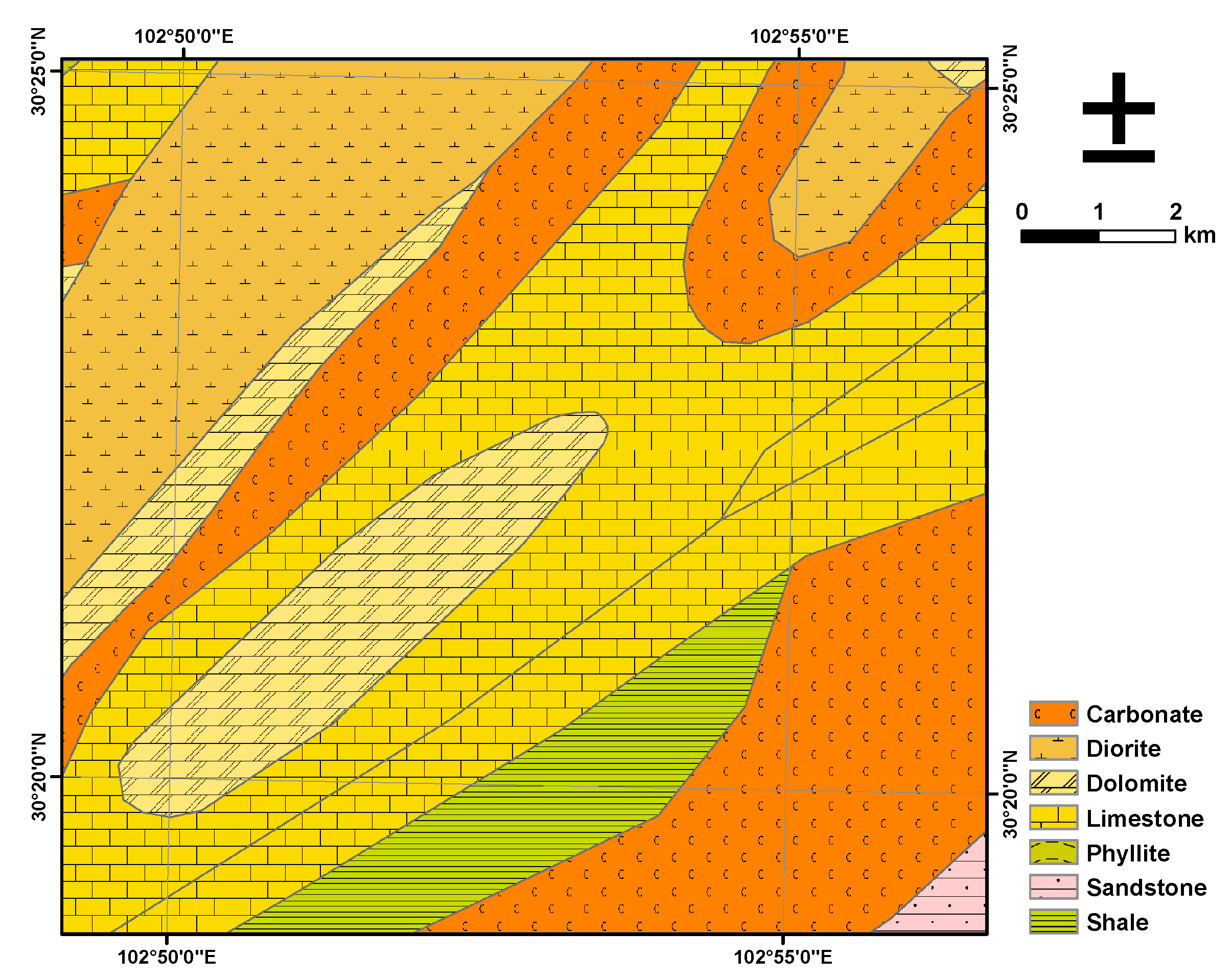
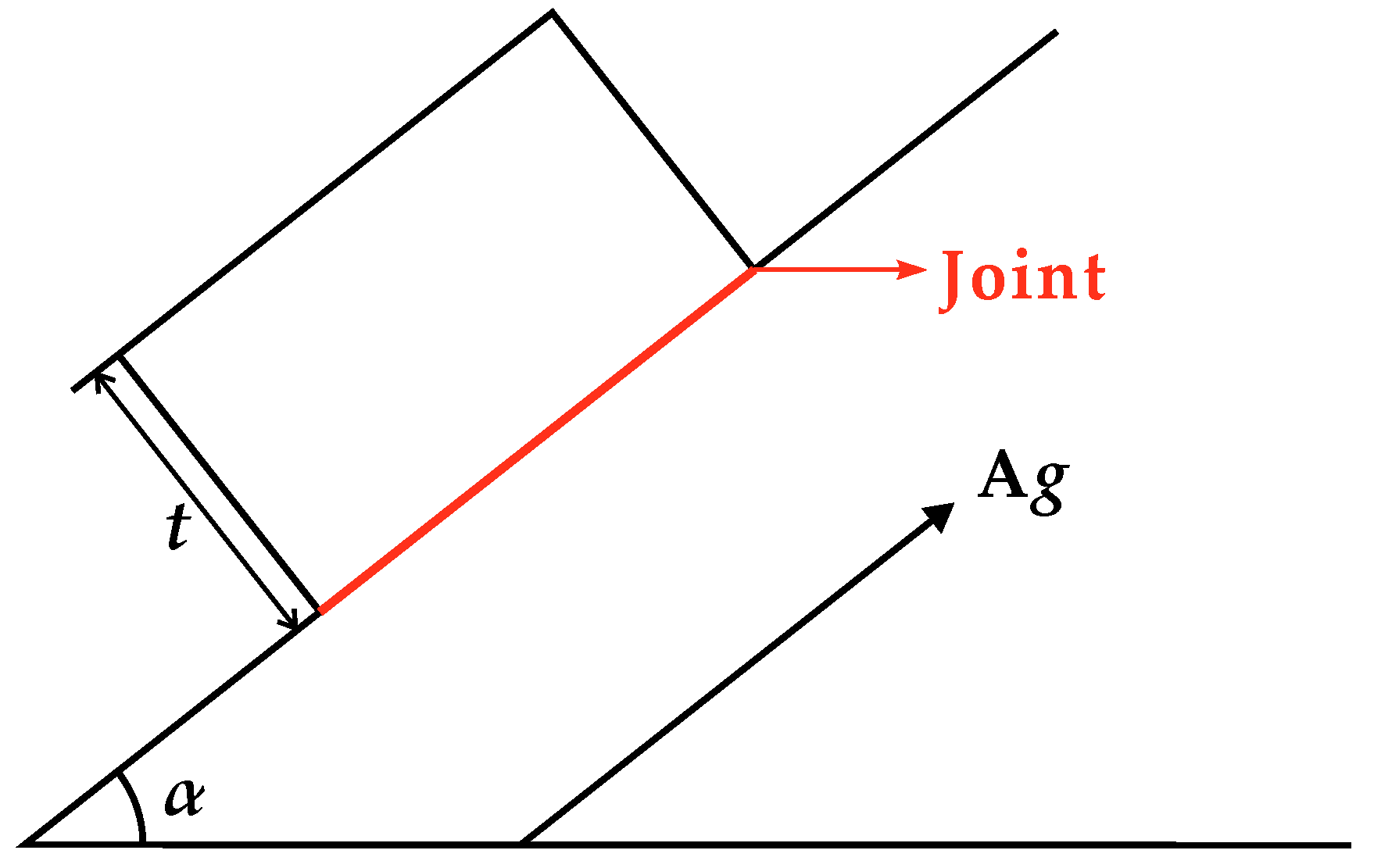



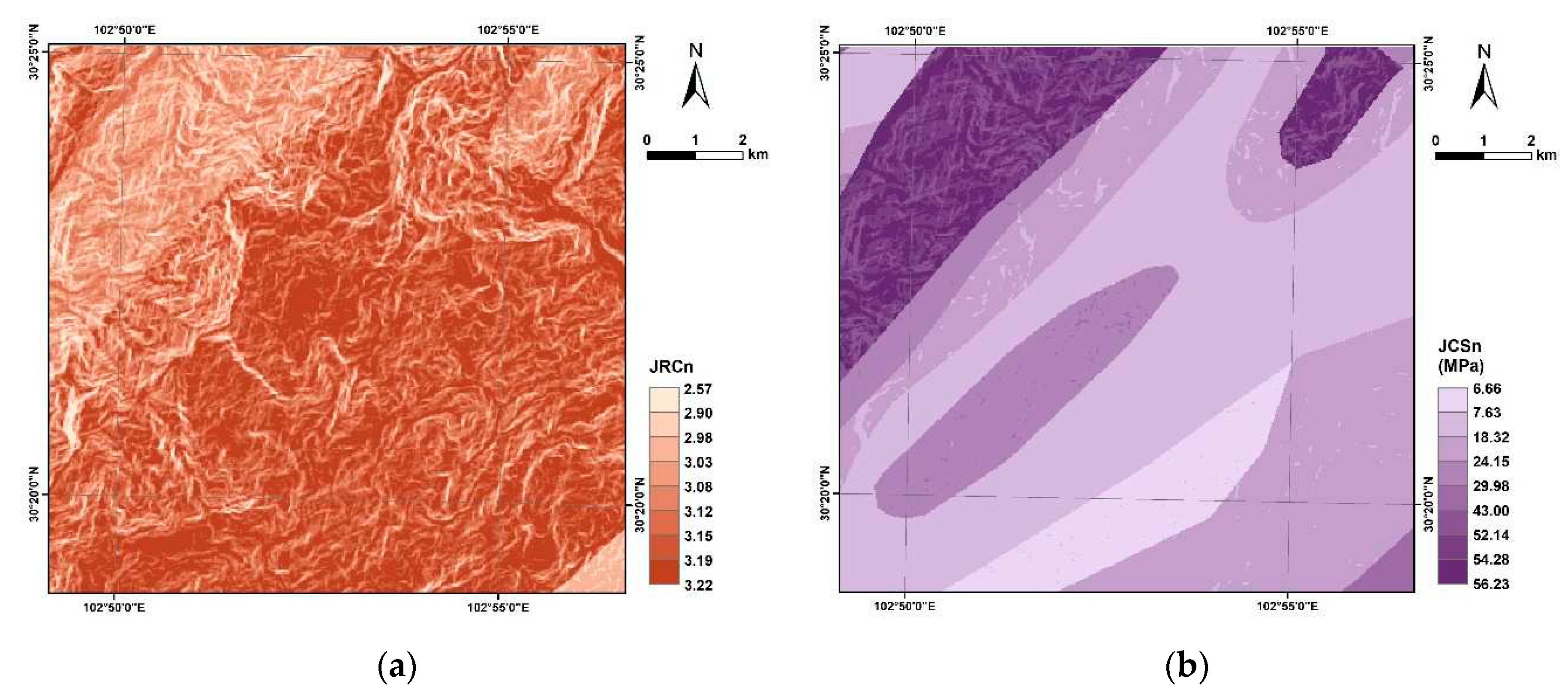

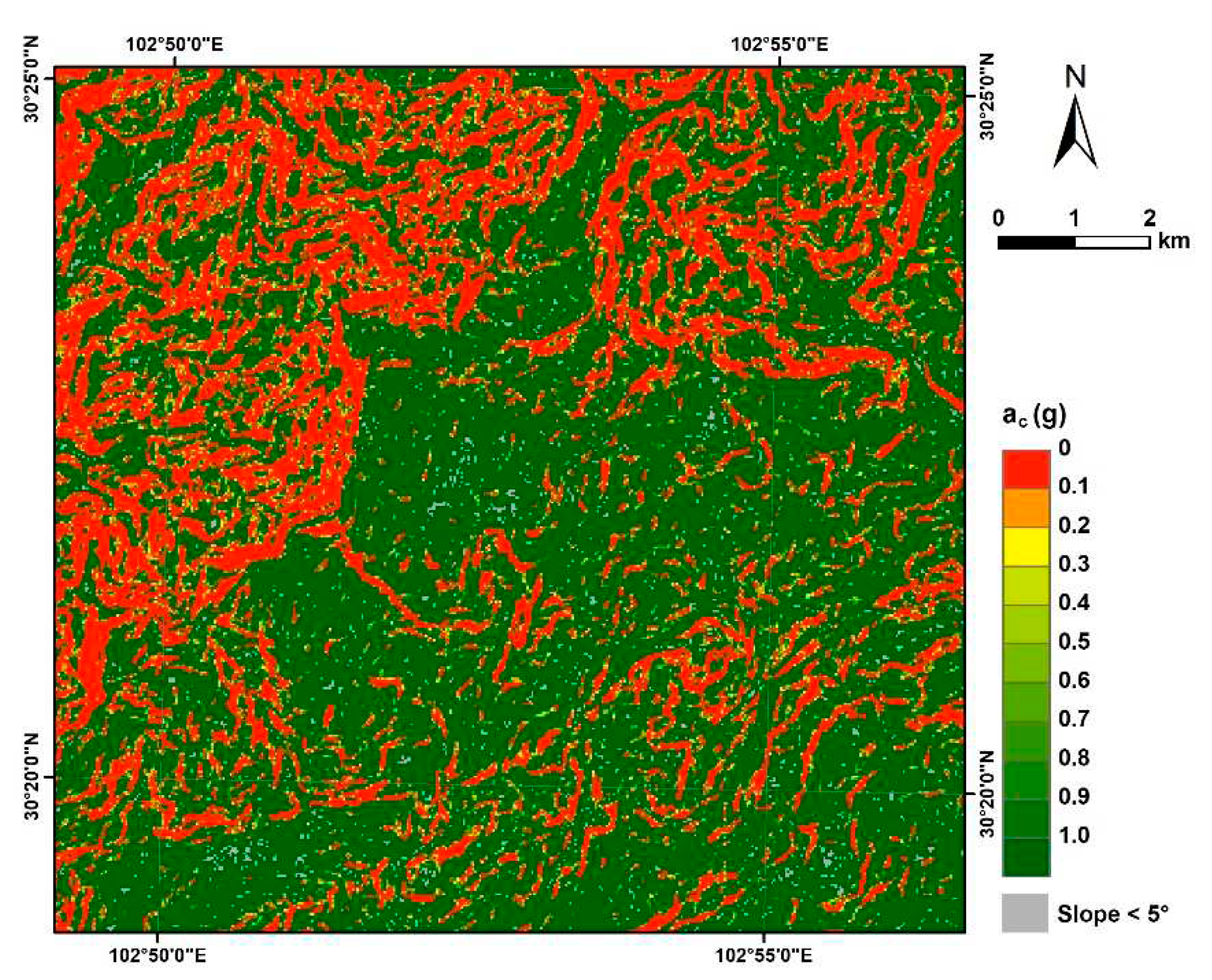




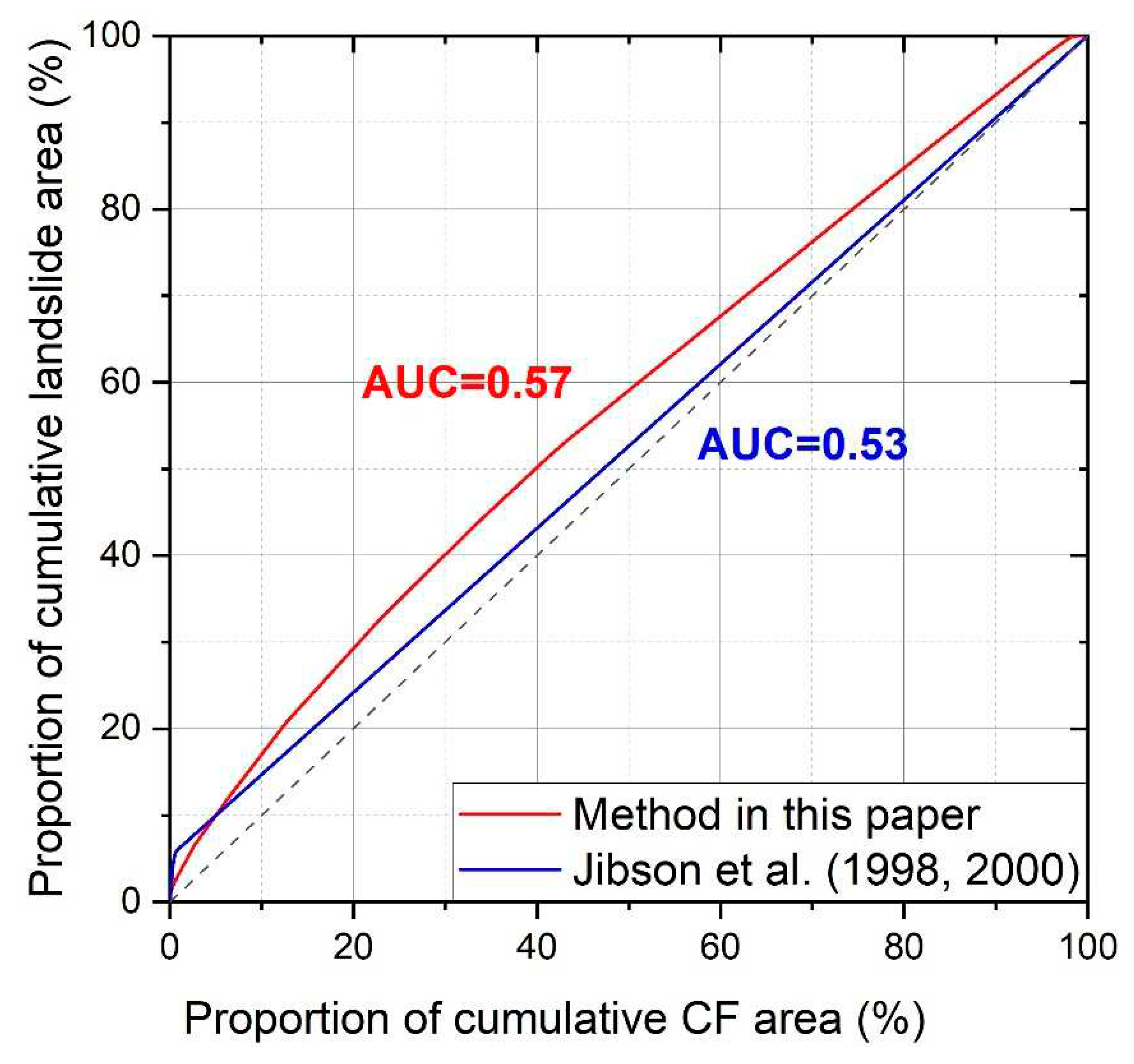
| Rock type | 1) | ) | 1 | 1 | References | ||
|---|---|---|---|---|---|---|---|
| Carbonate | 23.7 | 35° | 150 | 9.3 | 44° | 33 | Bandis et al. (1983) Singh et al. (2012) Alejano et al. (2014) Giusepone and da Silva (2014) Yong et al. (2018) |
| Diorite | 26.9 | 30° | 200 | 6.8 | 50° | 40 | Sirkiä, et al. (2016) Bao et al. (2020) |
| Dolomite | 25.9 | 32° | 140 | 9.5 | 43° | 35 | Singh et al. (2012) Alejano et al. (2014) Giusepone and da Silva (2014) |
| Limestone | 21.5 | 37° | 160 | 9 | 45° | 30 | Bandis et al. (1983) Singh et al. (2012) Yong et al. (2018) |
| Phyllite | 28 | 28° | 130 | 6 | 40° | 20 | Andrade and Saraiva (2008) |
| Sandstone | 23.5 | 35° | 100 | 6 | 42° | 24 | Coulson (1972) Bandis et al. (1983) Priest (1993) |
| Shale | 24.9 | 27° | 75 | 8 | 27° | 16 | Barton and Choubey (1977) Bilgin and Pasamehmetoglu (1990) |
Disclaimer/Publisher’s Note: The statements, opinions and data contained in all publications are solely those of the individual author(s) and contributor(s) and not of MDPI and/or the editor(s). MDPI and/or the editor(s) disclaim responsibility for any injury to people or property resulting from any ideas, methods, instructions or products referred to in the content. |
© 2023 by the authors. Licensee MDPI, Basel, Switzerland. This article is an open access article distributed under the terms and conditions of the Creative Commons Attribution (CC BY) license (http://creativecommons.org/licenses/by/4.0/).





